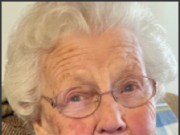Connections between the sun, the moon, and the Earth drive the seasons, ocean currents, weather, climate, and more. And the sun — our nearest and most visible star — will be putting on quite a show for us this month, with the help of the moon. On August 21st, the continental US will be treated to a solar eclipse. Sky-watchers in a 70 mile-wide band stretching from central Oregon, across the central US, to the central coast of South Carolina will experience a total eclipse, while viewers here in Ohio will see a partial eclipse, where roughly 80% of the sun obscured by the moon.
In Cleveland the eclipse will begin shortly after 1 pm, when the moon begins to obscure the sun’s upper right edge. Over time, more of the sun will be blocked until the maximum eclipse, set to occur at 2:30pm. At that time, the moon will block roughly 80% of the sun. While at no time will it get ‘dark’, it will get notably dimmer as maximum eclipse approaches — the brightness will be comparable to late afternoon or early evening. With no clouds in the sky, the dimming effect may feel unnatural, as surroundings take on a slightly grayish look, and shadows of objects will noticeably sharpen as the sun’s visible light narrows to a crescent. The moon will continue its course, with the event ending before 4 pm. This is the first time in 100 years that a total solar eclipse will be visible from coast to coast; the next similar event will take place in 2024.
Although you may be excited to have the opportunity to see this once-in-a-lifetime event, scientists warn potential eclipse-watchers not to look directly at the event without proper eye protection. Even viewed through multiple sets of sunglasses, ultraviolet, infrared, and bright visible light can damage or destroy sensitive eye tissue. Using special eclipse viewing shades or #14 welders’ plates can make direct observation safely possible.
Locally, there are several places to safely view this phenomenon. The Cleveland Museum of Natural History’s Ralph Mueller Observatory will be open for viewing the eclipse on Monday, August 21 from 1 to 4pm, weather permitting. Visitors will be able to observe the sun as its image is projected onto a screen through the Museum’s 3½ inch finder telescope. The facility will also have safe viewing glasses on hand for visitors’ use. Entrance to the Observatory is included in the CMNH’s general admission price.
In addition, the eclipse will be highlighted at the Great Lakes Science Center (GLSC) and NASA Glenn Research Center from Saturday, August 19 through Monday, August 21. The GLSC will host a weekend of hands-on activities, special demonstrations, simulcast eclipse coverage from around the country on NASA TV and even an outdoor sun salutations yoga session. Real-time eclipse footage will be viewable in the Center’s DOME Theater, the site of the NASA TV Watch Party from noon until 4 pm on 8/21. At the NASA Glenn Research Center, which is included with GLSC admission, visitors can learn from a NASA Research Center scientist and educators, who will provide hands-on exploration opportunities of the eclipse.
Closer to home, the Geauga Park District will host a Partial Solar Eclipse event at Observatory Park in Montville. On Monday, August 21st from noon until 4 pm, visitors will be able to safely watch Ohio’s first solar eclipse in recent years. You and your family will have the opportunity to try out several methods of viewing the sun safely, model the eclipse, and try other interesting hands-on activities. And best of all, this event is offered at no charge. The Portage Parks will also offer a free event that day, from 1 – 3 pm at the Portage Hike and Bike Trailhead in Ravenna (535 Cleveland Road). Telescopes and eclipse viewing glasses and telescopes will be provided to help visitors view the spectacular event.
In Hiram, the Hiram College Physics Department will host a Hiram Eclipse Watch on Monday, August 21, from 12:30 to 4:00 PM on the Hiram College Campus, just north of the Village Post Office on Hayden Street. The public is invited to watch what, in this area, will be a partial eclipse of the Sun which will reach its peak at 2:32 PM.
The event, which is free of charge, will offer free eclipse viewing glasses (while supply lasts), viewing of the eclipsing Sun through solar-equipped telescopes, opportunities to participate in eclipse observation and data collection, and live television coverage from areas experiencing a total eclipse.
If by chance it’s cloudy on Monday, August 21, your next opportunity won’t occur until April 8, 2024, when a total solar eclipse takes place directly over northern Ohio, with Cleveland positioned almost exactly on the eclipse center line. A total eclipse occurs at a given location only about once every 350 years, so Northeast Ohioans will have some of the best seats available for that phenomenal show.












